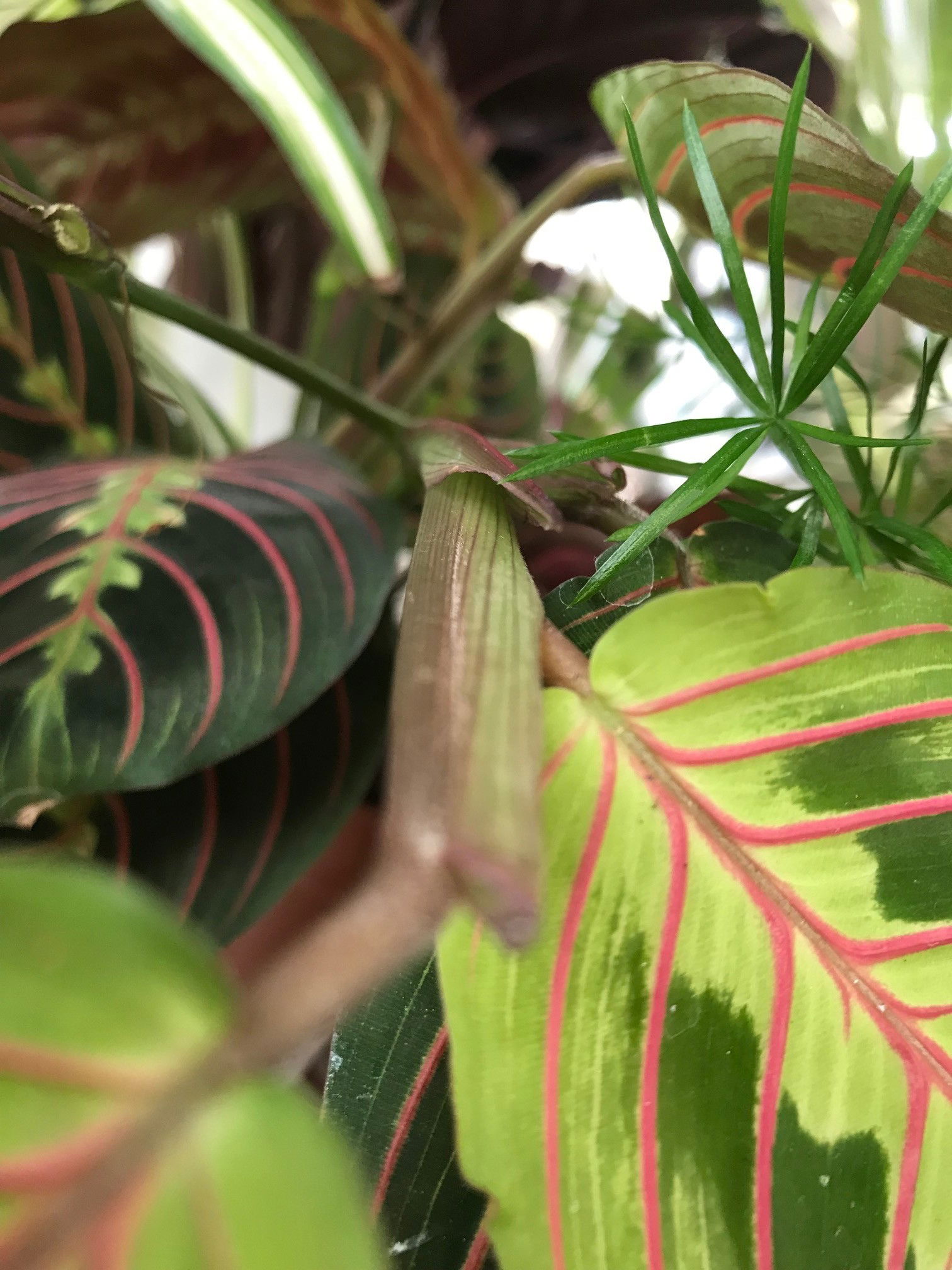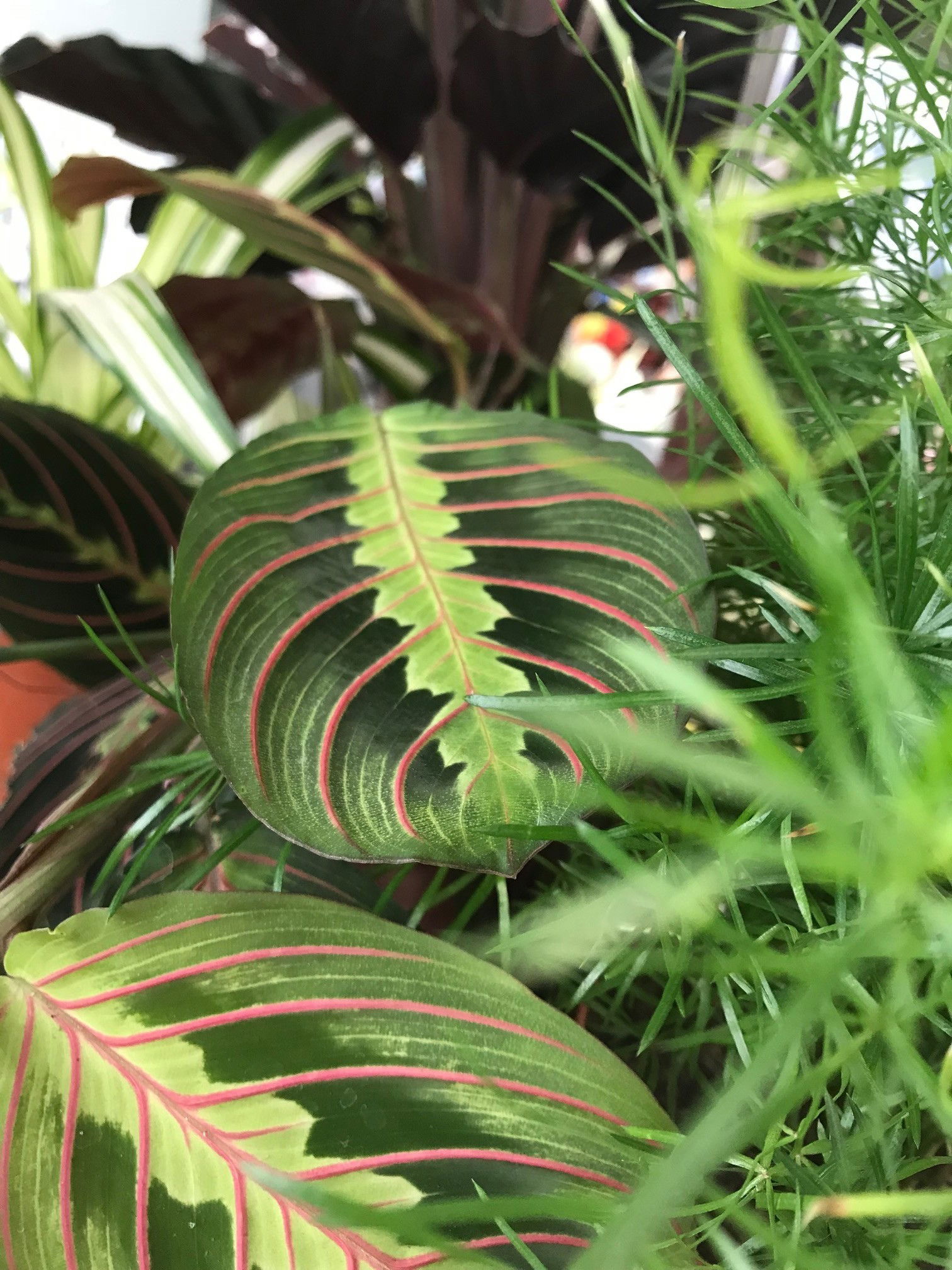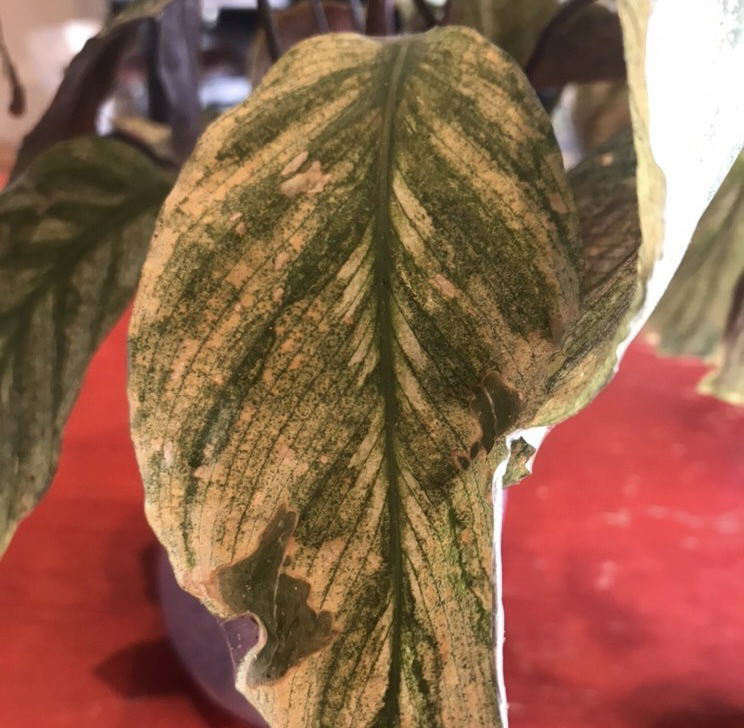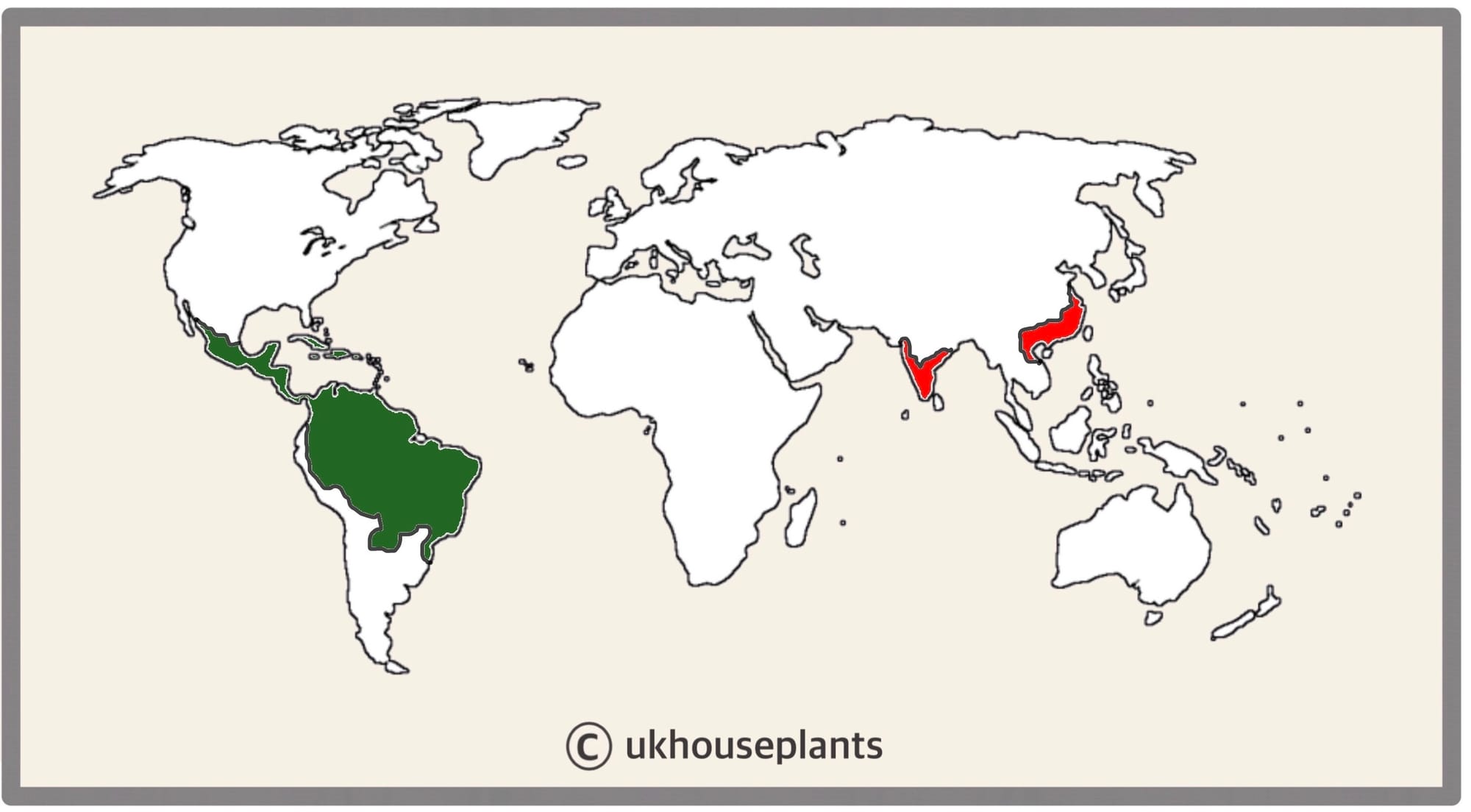
Maranta leuconeura 'Fascinator'
Contents
- Top Tips
- Location, Water, Humidity & Fertilisation
- Common Issues
- Origins, Temperature, Propagation, Repotting & Toxicity.
Need the answer to a specific plant query, for instance, root rot or yellowing leaves? Book a 1-to-1 video call with THE HOUSEPLANT DOCTOR™, the website's friendly author, to overcome and address your niggling problem! Available on iMessage, WhatsApp, Facebook Messenger & more.
Top Tips & Info
- Care Difficulty - Moderate
- Present a bright, indirect location, avoiding prolonged exposure to the sun, especially in the summer. A setting that's either too bright or dark will cause the variegations (foliar patterns) to weaken.
- Maintain evenly moist soil, allowing the top third to dry out in between hydrations. Avoid promoting droughts due to the heightened chance of yellowing leaves and weakened growth.
- Provide a good level of humidity by misting the foliage weekly or creating a pebble tray (recommended).
- Fertilise using a 'Houseplant' labelled feed every four waters in the spring and summer, reducing this to every six in the colder months.
- In spring, repot every three years with either a 'Houseplant' or 'Calathea & Maranta' soil mix; water the plant 24hrs beforehand to reduce the risk of damaging the root hairs ('transplant shock').
- Keep an eye out for Spider Mites & Mealybugs that'll located themselves in the leaves' cubbyholes.
Location & Light - 🔸🔸
Perfecting the amount of light a Maranta receives is crucial for a long-lasting specimen. During the spring and summer, be sure to provide a brightly lit spot away from any direct light. Excessive exposure during this time will negatively affect the plant in the likes of sun scorch and dehydration. Once the autumn kicks in, include an hour or two of morning sunlight per day to get it through the dormancy period, lasting until the following spring. Always ensure thorough soil moisture while under the sun's rays.
If the Maranta has red undersides, a shadier position in a house is also acceptable because of their ability to absorb light through the backs of their leaves via the simple mechanism of the colour itself! If, however, its nyctinastic movements become less prolific, you're running the risk of too low light and weakened health.
Water - 🔸🔸
Allow the top quarter of the soil to dry out in between waters during spring and summer, reducing this further in the dormancy period. Under-watering symptoms include crispy or distorted new growth, curling leaves, crispy or dry patches and yellowing leaves. Juvenile specimens that lack a sufficient rhizome system are most likely to be hard-hit by extended periods droughts, due to their inefficient capability to store moisture. Scroll down to 'Common Issues' for more information on addressing a total loss of foliage. Over-watering symptoms include rapidly yellowing leaves, leaf spot disease, stem collapse and plant death. These issues are commonly caused by too little light/heat, poor cultivation habits or water-logging.
Humidity - 🔸🔸🔸
Create a humidity tray to provide a moist and stable environment for your plant. If the surrounding saturation is too low or the heat too high, its leaves may start to brown over and curl, especially in direct sunlight. Hose the foliage down from time to time to hydrate the leaves and keep the dust levels down. Those situated in either a bathroom or a dark location must not be over-misted as too much moisture surrounding the foliage will result in powdery mildew and leaf-spot disease.
Fertilisation - 🔸
Feed every four waters during the growing period and every six in the autumn and winter, using a 'Houseplant' labelled fertiliser. Never apply a 'Ready to Use’ product into the soil without a pre-water first, as it may burn the roots and lead to yellowed leaves.
 The species' epithet, leuconeura, can be translated from Latin to mean 'white viens', in reference to the foliage's variegations.
The species' epithet, leuconeura, can be translated from Latin to mean 'white viens', in reference to the foliage's variegations.
Common Issues with Maranta
When a Maranta is severely dehydrated, most of its leaves will crisp-up and fall off - leaving you with a naked stem. Although it may spell the end of juvenile plantlets, there may still be light at the end of the tunnel for more established specimens. If its stem is still plump without any signs of retraction, prune-away the seriously affected areas and contain the plant (with its pot) in a transparent bag that has small holes. Keep the soil relatively moist, providing a good level of indirect light and temperatures above 18°C (64°F). After a few weeks, new leaves should form from the stems, signalling the start of its recovery process.
Root rot is a common issue with specimens sat in too moist or waterlogged soil for long periods. Symptoms include rapidly yellowing leaves, stunted growth and a rotten brown base. Take the plant out of the pot and inspect health below the soil line. If the roots sport a yellow tinge, you're good to go, but if they're brown and mushy, action must be taken immediately. More information about addressing root rot can be found on this link.
Yellowing lower leaves (closest to soil) are a clear sign of over-watering, usually aggravated by too little light. Although they can do well in darker locations, the frequency of watering must be reduced to counteract the chance of root rot. Only rehydrate the soil once the top third dries out, using lukewarm water with fertiliser every third hydration. Consider relocating your Maranta to a slightly brighter area in the home, still avoiding direct sunlight though.
Mould developing on the soil means two things; too little light and over-watering. Despite the harmlessness of this mould, you can easily remove it by replacing the top two inches of the soil for a fresh batch of 'Houseplant' labelled compost. Either increase the amount of light received (still no direct sunlight though) or decrease the frequency of waters. If the mould is accompanied by yellowing lower leaves, you may also have a case of root rot.
Too much sunlight will lead to sun scorch, with typical signs including crispy leaves, dry leaf-edges and stunted growth. Although too little light will cause over-watering issues, over-exposure will be an issue, too. Relocate your Maranta into a slightly darker area of the home, like a north, north-east or north-west windowsill to recover and remove any affected leaves. Never place this sun-burnt plant in an overly shady spot as it may result in environmental shock.
For Maranta grown more than 2m (6ft) away from a window, use a chopstick to gently stab the soil in various areas to aid aeration around the roots. With a chopstick or pencil, penetrate the compost exactly between the plant's stem and the pot's edge, being cautious of its root system. Not only will the gentle shift in the soil's structure mimic the work of small creatures in the wild (worms, etc.), but it'll also add oxygen back into the soil, thus reducing the risk of root rot. Repeat this monthly, or whenever you feel the potting-mix isn't drying out quickly enough.
Always use lukewarm water, and if you choose to use tap water, allow it to stand for at least 12hrs before application. Maranta tend to be quite sensitive to temperature change, so pouring cold tap water immediately into the pot will not only add chlorine into the soil, but it could even result in a weakened plant due to the sudden low temperatures.

Spider Mites are small, near-transparent critters, that'll slowly suck out the chlorophyll out of the leaves. Have a check under the leaves, most notably along the midrib, for small webs and gritty yellow bumps. Click here to read our article about the eradicating Spider Mites, along with some extra tips that you may not find elsewhere!
Too low humidity can cause browning tips with yellow halos on juvenile leaves. Mist or rinse the foliage (in the shower or kitchen tap) from time to time and create a humidity tray while the heaters are active to create a stable environment. Note: In most cases, however, older leaves that develop crispy tips is entirely natural and is the product of extensive daily photosynthesis during its life.
Failed propagated stem cuttings - There are several reasons why the cuttings haven't rooted well, including: the time of year (spring or summer is best), its size (Maranta cuttings should have at least three leaves), poor growing conditions (replace water weekly for water-propagated cuttings, and avoid over-watering for soil-grown plants), and its growing environment (a bright sunless windowsill and warmth is important).
Origins
Maranta is a genus consisting of fifty species, native to the tropical Americas. It was first described by Carl Linnaeus in 1753, honouring Italian botanist, Bartolomeo Maranta, who performed most of his work in the mid-sixteenth-century. Marantaceæ is the taxonomic family of Maranta, as well as the closely related genera of Calathea, Ctenanthe & Afrocalathea.
 The Distribution of Maranta in Green, with several species being introduced in China & India (Red).
The Distribution of Maranta in Green, with several species being introduced in China & India (Red).
Temperature
15° - 27°C (59° - 80°F)
H1a (Hardiness Zone 13) - Must be grown indoors or under glass all year round. Never allow temperatures to dip below 15℃ or permanent damage may occur in the likes of flower loss, stunted growth and yellowed leaves.
Spread
Up to 1m in stem length when reaching their maturity of six years, with up to 15cm (three leaves) of new growth developing each year.
Pruning & Maintenance
Remove yellow or dying leaves, and plant debris to encourage better-growing conditions. While pruning, always use clean scissors or shears to reduce the chance of bacterial and fungal diseases. If you're uninterested in its blooms, prune away flower spikes that emerge in the spring or summer to divert energy back into leaf production.
Propagation
Via Seed, Stem Cuttings & Rhizome Division.
Stem Cuttings (Easy & Recommended for Beginners)
- Choose the healthiest stems tips on the plant. This propagation method can be taken from spring to summer, using between three to four leaves with the main STEM being at least 10cm (3 inches). Remember that each node (where the leaf joins the stem) is a site for rooting and new foliar development.
- While holding the end of the stem, cut directly below the third leaf using a clean knife. Remove the oldest leaf (the one furthest from the new growth) and place upright (& wound down) in a jar of lukewarm water and in a sunless windowsill.
- Replace the water weekly, using lukewarm water to avoid shocking the cutting with cold temperatures.
- Once the roots surpass 4cm (2 inches) in length, which may take up to two months, it's time to transplant the cutting in a 10cm pot with 'Houseplant' labelled compost.
- Fill the pot's bottom quarter with soil and stand the cutting vertically on top (rooted end on the potting mix). Fill the remaining gaps with compost until the pot is three-quarters full, ensuring no leaves become submerged.
- Thoroughly hydrate the soil and continue to provide bright, indirect windowsill with fertilisation every third water. If the cutting begins to wilt shortly after transplant, wrap the plant (& its pot) in a transparent bag or box while maintaining the same windowsill. The enclosed environment within the bag will become more humid, thus reducing the risk of leaf-curling through dehydration.
- Remove the bag once a new leaf emerges from the cutting and treat like a mature specimen.
Rhizome Division (Moderate)
- When a Maranta is purchased, the chances of the pot having at least three (or more) separate plants is very high. Separating these individual plants into their own pot will not only expand your plant collection, but it'll also slow the process of becoming pot bound. The best time to divide is during the spring, with the stem's length surpassing 15cm (6 inches).
- Hydrate the soil and brush away some of the soil to gain better access to the plants' bases. Gently tease the each plant's rootball apart, keeping in mind the delicacy of this task and the avoidance of 'transplant shock'.
- With three 10cm pots, fill the bottom quarter with either 'Houseplant' or 'Calathea & Maranta' labelled potting mix and sit the rootball on top. Fill the remaining gaps with soil and hydrate thoroughly with lukewarm water.
- Maintain a bright sunless windowsill and observe for wilting/curling foliage. If this occurs, wrap the plant (& its pot) in a transparent bag or box while maintaining the same windowsill. The enclosed environment within the bag will become more humid, thus reducing the risk of leaf-curling through dehydration. Remove the bag once a new leaf emerges from the cutting and treat like a mature specimen.
Flowers
Maranta will naturally flower in the warmer months of the year, sporting small purple (or yellow) flowers at the tips of each stem. The flowers only last around two weeks at most, which is why this group of plants are mostly grown for their beautiful variegatied leaves. Here's an example of their flower below.
Note: The flowering process can take energy out of the plant that could otherwise be directed to the plant's overall health. If you're uninterested in its blooms, consider snipping them off to help promote more stunning foliage!
 The inflorescence of Maranta leuconeura 'Fascinator'.
The inflorescence of Maranta leuconeura 'Fascinator'.
Repotting
Repot every three years in spring using either 'Houseplant' or 'Calathea & Maranta' labelled potting mix and the next sized pot with adequate drainage. Hydrate the plant 24hrs before tinkering with the roots to prevent the risk of transplant shock. For those that are situated in a darker location, add a thin layer of small grit in the pot's base to improve drainage and downplay over-watering. Click here for a detailed step-by-step guide on transplantation, or via this link to learn about repotting with root rot.
If you're still unsure of what to do, don't hesitate to book a 1-to-1 call with THE HOUSEPLANT DOCTOR™ to get his expert advice on transplantation!
Pests & Diseases
Keep an eye out for mealybugs, spider mites, thrips, whitefly & root mealybugs that'll locate themselves in the cubbyholes and undersides of the leaves, with the exception of the latter in soil. Common diseases associated with Maranta are root rot, leaf-spot disease, botrytis, rust, powdery mildew & southern blight - click here to learn more about these issues.
Toxicity
Not known to be poisonous when consumed by pets and humans. If large quantities are eaten, it may result in vomiting, nausea and a loss of appetite.
Retail Locations
Garden Centres, DIY Stores & Online Stores.
Book a 1-to-1 Call with THE HOUSEPLANT DOCTOR™
If you need further advice with your houseplants, book an advice call with ukhouseplants' friendly and expert writer today! This can be done via a video or audio call on most apps, including Facebook, FaceTime & Skype. A ten-minute call costs £5.99 (US$7), or £15.99 for thirty minutes. You can ask multiple questions, including queries on plants, pests, terrariums, repotting advice and anything in between. Please consider supporting this service to keep ukhouseplants thriving!